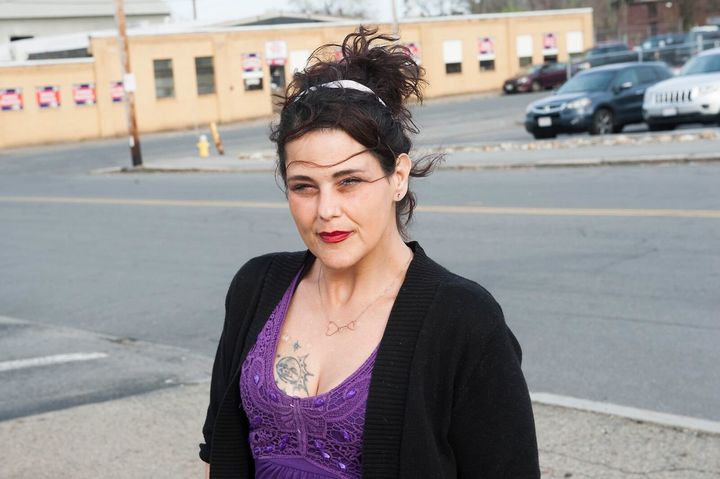
LAWRENCE, Mass. ― Rachael Pomerleau, 40, had taken opioids before, having had procedures like wisdom teeth removal and gallbladder surgery.
But during the tumultuous two years that her children, now ages 7 and 8, were born, opioids took over her life, she told HuffPost. She was put on bed rest as a result of complications with the pregnancy of her daughter. A few months after her daughter’s birth, she became pregnant with her son. This time, her back and abdominal pain grew so severe that doctors prescribed Vicodin followed by Percocet during her pregnancy ― which wasn’t an unusual prescription for pregnant women at the time, prior to the onset of the opioid epidemic.
“It hurt so bad,” she said. “There were times when I could hardly walk without being in pain.”
When Pomerleau returned from maternity leave for the second time, she said, she lost her job at a local health care services company. And she kept taking opioids ― oxycodone this time ― this time prescribed to her by her primary care doctor.
Women like Pomerleau, who was prescribed opioids in a medical setting and became addicted to them, are a growing demographic in the United States’ opioid epidemic. Although men continue to have higher rates of substance use than women do, the gap between the sexes is narrowing, with prescription opioid overdose deaths rising 583 percent among women between 1999 and 2016, compared to 404 percent among men, according to the National Institute on Drug Abuse.
But even as prescription opioid death rates grow among American women, doctors, researchers and policymakers don’t yet understand how to properly screen for or address female opioid users’ unique needs. In an essay published in the most recent issue of the medical journal, The Lancet, two Yale medical researchers warn that America won’t be able to address its raging opioid epidemic if it continues to overlook women’s unique pathways to opioid misuse ― and the factors that hinder their access to treatment.
“The system is evolving — but we’re at a point now where there’s a need to have it do so more rapidly, just based on the sheer volume of women who are being impacted,” said Dr. David Fiellin, who directs Yale’s addiction medicine program and co-authored The Lancet article.
Women Have Unique Exposure To Opioids
There are several factors, both biological and cultural, that differentiate women who use opioids. Population-based studies suggest that women are more sensitive to painful stimuli than men are, putting them at a higher risk for chronic illness that includes pain and making them better candidates for painkillers.
There’s also some evidence that women become addicted to substances more quickly than men do, although the biological mechanism for this phenomenon isn’t understood, said Fiellin.
Women are more likely to have medical interventions than men are, including reproductive and childbirth-related procedures. As a consequence, women are more likely than men to be prescribed opioids in medical settings.
Pregnancy and postpartum pain in particular lead to significant initial exposure to opioids. For example, 1 in 300 women who didn’t previously use opioids and had a cesarean section will become a persistent opioid user, according to the American Congress of Obstetricians and Gynecologists. And two separate studies each published this year in the journal Obstetrics and Gynecology found that women were over-prescribed opioids after both vaginal and cesarean births.
Depression and anxiety disorders are also more common among women, as are sexual trauma and partner violence, all of which are risk factors for abusing opioids. Women are also more likely than men to report that they use opioids to cope with negative emotions and pain.
For Pomerleau, physical pain was compounded by an abusive relationship and childhood trauma, she said, that left her with post-traumatic stress disorder, major depression and anxiety. But her steady access to opioids during and after pregnancy was the ignition that has led to a multi-year struggle with addiction that has included homelessness, loss of custody of her children and struggles to get the resources she needs.
Importance Of Screening At-Risk Women For Opioid Addiction
During the five years after her kids were born, oxycodone and constant pain were the backdrops of Pomerleau’s life. Her tolerance for the pain pills grew and she says she sometimes gave them away to family and friends. Then one day, she came home and realized that sharing her prescription had backfired ― her supply had run out and her doctor wouldn’t prescribe her more pills.
“I got so sick,” she said of the withdrawal that followed. “It was horrible. I had no way of doing anything.” She went to a methadone clinic for help. “There was no other way,” she explained. “My tolerance was like someone who was out doing dope for years.”
It took five years for Pomerleau’s doctors to notice she had a problem.
Her story is sadly representative of what Carolyn Mazure, the director of Women’s Health Research at Yale and the lead Lancet author, has found in her research. She likened the current gender blind spots in opioid use disorders among medical professionals to the way heart disease was approached in the past.
“People thought [cardiovascular disease] was the greatest killer of men, which it is, but they were not aware of the fact that it also was the greatest killer of women,” Mazure said.
As recently as 2005, fewer than 1 in 5 physicians knew that more women die of cardiovascular disease each year than men do, according to a study published in the journal Circulation, a knowledge gap that likely contributed to women arriving later to the ER and experiencing delays in treatment when they had the same cardiovascular symptoms that men did.
That same knowledge gap has created a murky territory for doctors and their female pain patients.
On the one hand, the potential for addiction among women who were prescribed opioids has often been overlooked by medical professionals. On the other, many women report that their doctors aren’t taking their pain seriously nor sufficiently treating it.
“So many people think it’s a cop out,” Pomerleau said of her own ongoing pain. “I have no problem doing whatever the doctor says or suggests. He’s the one that’s supposed to be making the best decisions for me. At the same time, I can’t have this much pain.”
A failure to focus on women can result not only in inappropriate treatment but serious medical misjudgments, according to Mazure and Fiellin, who pointed to a study that found that women in Rhode Island were three times less likely than men to receive the opioid overdose reversal drug naloxone in emergency medical settings, a discrepancy which could indicate unrecognized gender bias among emergency medical service providers.
Women-Centered Services Require More Than Treating Addiction
Lawrence, Massachusetts, has uncommonly comprehensive health and homeless services compared to many areas of the country. There’s a mobile health service where Pomerleau, now on a daily methadone dose, has sought care, and a homeless shelter where she lived this spring, before moving in with a friend.
Historically speaking and nationally, however, methadone programs haven’t been particularly friendly to women, Fiellin explained, since they lacked supportive services like screening and counseling for intimate partner violence, job training, childcare and resources for pregnant women, all of which can help retain female clients.
There is a cultural expectation that women are the primary caregivers of children, and a social stigma against mothers with addiction that can cause women to delay treatment, fearing they’ll lose custody of their kids, particularly if they’re pregnant.
To help meet women’s needs, treatment centers might have to spend more time figuring out how women are going to be able to come for treatment if they have kids at home, and talking to them about intimate partner violence if that’s something that worries them, Mazure explained.
That’s the reason women tend to do better at tailored programs that offer women-centered services, like childcare and domestic counseling, she said.
Despite the lifesaving care of her clinic, Pomerleau faces an uphill battle trying to accrue these services for herself. Her days are consumed with efforts to keep her social security benefits intact, court appearances to determine the guardianship of her children and daily treatment.
Until then, her kids are living with her sister in nearby Methuen.
There have been some efforts to focus on women, such as by the National Institute on Drug Abuse, which has invested in studying pregnant and parenting women with opioid addiction. But as Mazure and Fiellin note in their article, bridging the gap to treat and prevent opioid addiction in women will require significant commitment from researchers, clinicians and policymakers.
In the meantime, women like Pomerleau are caught in the balance.
“I always had an apartment. A nice place to live,” she said, describing how losing housing changed everything for her.
“All I really want is just to have [my kids] back,” she said.
